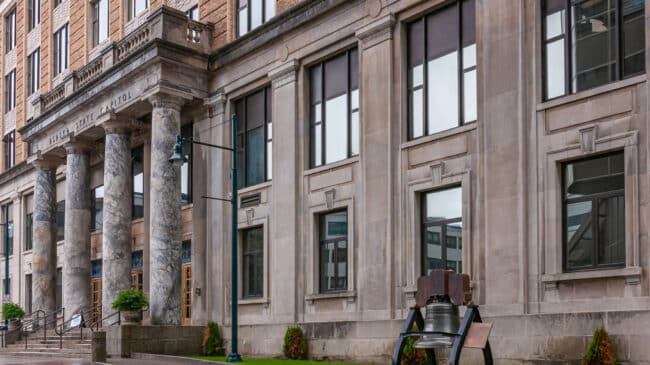Two competing public employee pension bills reached the Alaska House of Representatives last week. One would revert Alaska back to a fiscally unsustainable public pension plan that adds to the state’s debts, while the other would maintain important reforms and even allow the state’s teachers to access a better, more flexible retirement plan.
Senate Bill 88 (SB 88), sponsored by and passed out by the Alaska Senate Republican Caucus, would reopen the defined benefit (DB) pension plan closed in 2005 for public employees, teachers, and public safety personnel. An opposing proposal, House Bill 302 (HB 302), sponsored by Rep. Ben Carpenter (R-Nikiski), would leave the defined contribution retirement plan (DCRP) open, increase the employer contribution rates for public safety, and—crucially—open access to the Supplemental Benefit System-Annuity Plan (SBS-AP) to teachers.
The SBS-AP is an Alaska-specific Social Security replacement plan. As we’ve written previously, the current defined contribution (DC) plan is better suited for today’s more mobile workforce because employees can take their accumulated retirement savings with them when they change jobs. Instead of rolling back crucial public pension reforms made to protect Alaska’s budget from runaway costs, state policymakers should look to improve on the DC benefits already being offered to public safety workers and teachers.
As discussed in Reason Foundation’s gold standard series on retirement design, a vital component of a successful defined contribution retirement plan is adequate contributions. The goal of a DC plan should be to replace approximately 80% of a worker’s final salary upon retirement. This means the primary DC plan should target, when combined with Social Security or any supplemental alternative, a contribution amount of 22%-to-27% of pay for public employees and teachers and 30% for public safety employees.
Under Alaska’s current pension design, Public Employee Retirement System members and public safety members are covered by the DCRP and the SBS-AP, with a total employer and employee contribution of 25.26%. Best practice standards are met for regular PERS members but fall short of the 30% contribution target for public safety members. Alaska’s teachers—whose union chose not to participate in the SBS-AP program when offered the option many years ago and also do not participate in Social Security—have a combined 15% DCRP contribution, which is substantially below the target contribution range.
Under HB 302, public safety employer contributions would be substantially increased from 5% of pay to 9.74% of pay. When combined with SBS-AP contributions, public safety contributions would be at the 30% benchmark. Teacher members of the DCRP would begin participating in the SBS-AP, resulting in a total contribution of 27.26% of pay. With these changes, best practice contribution adequacy standards would be met for both public safety and teacher members. The bill would also make Alaska home to some of the most generous public retirement benefits in the country, all being offered at zero risk of future unfunded liabilities.
A counterfactual analysis performed last year, when a proposal to reopen the defined benefit public pension system was making its way through the Senate, pointed out how just one year of investment results in 2022 would’ve added $200 million in unfunded liabilities. In other words, had a bill like SB 88 been enacted last legislative session, the plan would have already been $200 million in debt from that decision, and that is only the short-term peril posed by the idea of diving back into defined benefit public pensions.
In the long term, if investment performance matches what most financial forecasters are expecting, the DB proposal would likely add $9 billion to Alaska’s unfunded liabilities. There was no discussion in the Senate, prior to them passing SB 88 out of the chamber, of looking at the impacts of poor market performance or the real possibility of the state or country experiencing an economic recession over the next 30 years. To date, the Pension Integrity Project’s analysis is still the only actuarial analysis that shows any sort of stress testing on SB 88.
At the heart of the discourse, the contrasting proposals of SB 88 and HB 302 represent a critical juncture for the state’s approach to public sector retirement benefits. The decision is not merely a technical adjustment of pension plans but a reflection of deeper values concerning fiscal responsibility and the welfare of public employees. SB 88’s proposal to return to a defined benefit system, while appealing for its stated, yet unproven promise of helping the state’s woes with worker recruitment and retention, is overshadowed by the looming threat of adding unfunded liabilities. After all, Alaska closed its DB pension 20 years ago but is still dealing with over $6.7 billion in unfunded liabilities from it.
In contrast, HB 302 offers a robust alternative for workers and government agencies. By refining the DCRP by augmenting the contributions for public safety personnel and incorporating teachers into the SBS-AP, the proposal ensures that the retirement system is both generous and financially viable. The increased contributions to employees’ DCRP come with increased costs to the state, but those increases go directly to the retirement of Alaska’s public workers rather than being used to keep afloat an underfunded pension system. This is a retirement plan designed not just for the present but with an eye firmly on the future, avoiding the debt and unsustainable fiscal pitfalls of Alaska’s legacy pension plan.
The analytical evidence tilts strongly in favor of HB 302, presenting it as the safer, more equitable path forward. This approach promises a future where Alaska’s public servants can look forward to their retirement with confidence, supported by a system that is both fair and financially sound. As state lawmakers consider their options, the decisions between House Bill 302 and Senate Bill 88 could well define Alaska’s fiscal landscape for generations to come, either ensuring a legacy of prudent, responsible stewardship of the state’s public sector retirement system or adding billions in debt for future Alaskans to pay.
Stay in Touch with Our Pension Experts
Reason Foundation’s Pension Integrity Project has helped policymakers in states like Arizona, Colorado, Michigan, and Montana implement substantive pension reforms. Our monthly newsletter highlights the latest actuarial analysis and policy insights from our team.

